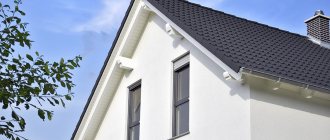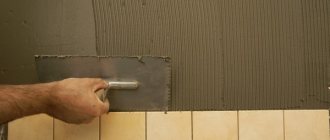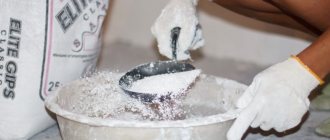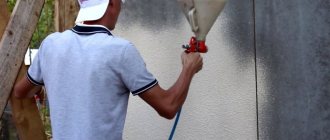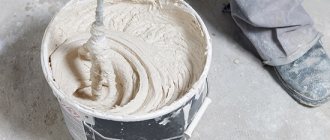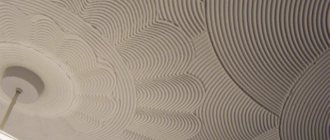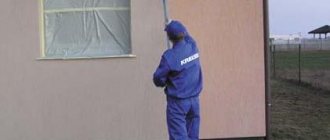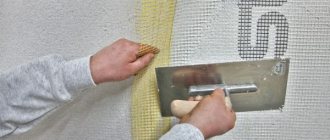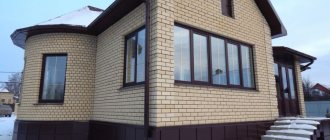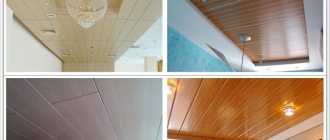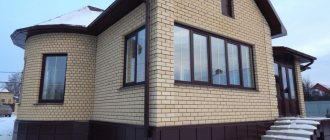8696 0 1
Vadim June 13, 2017
What façade putty for exterior use is currently on the market? Let's find out together what types of putty exist, what these or other compounds are used for, and what brands make a quality product. And for the DIYers, I’ll tell you how to putty the facade of a house for painting with your own hands in two ways.
Puttying the facade is one of the main stages of home improvement.
Types of putty compositions
Facade putty for exterior use is available in a variety of options.
Classification by purpose
When starting repair work, it is worth deciding what the putty will be needed for. Facades are treated using the following types of putty:
- starting or basic. With their use, surface irregularities are removed. They have increased adhesive properties. But the wall will not be completely smooth, since the mixture consists of too large fractions. The layer can be up to 2 cm thick;
- finishing. When using such a putty, the starting composition is first applied, and only then the finishing composition. If the wall is smooth, then the finish is applied immediately. The layer should be no more than 4 mm, so less material is consumed per square meter;
- decorative. Such compositions make it possible to obtain original facade decor and protect external walls from adverse weather conditions. There are options with different fractions and methods of application. The decorative layer has a thickness of no more than 7 mm;
- for wood processing. This option consists of waterproof compounds that strengthen the wood and extend the life of the facade.
Attention! There are materials that combine several properties. They are suitable for exterior finishing and provide reliable adhesion to the surface.
Classification by composition
Construction companies offer several types of compositions:
- Cement. They are used to treat concrete structures covered with large cracks. The compositions are produced in different versions with additives to improve properties. They can withstand low and high temperatures. The cost of the material is affordable, and the work is not difficult to carry out. But after some time, the material shrinks and cracks may form.
- Acrylic. Suitable for leveling and decorating surfaces. The composition must be applied with a thickness of no more than 0.3 cm. In this case, the surface is prepared and primed in advance. The material is moisture-resistant, durable and elastic, making it ideal for outdoor use. This is an elastic putty that will not quickly repair deep cracks.
- Latex. These are paste-like compositions with improved technical characteristics. They have good frost resistance and moisture resistance. The compositions are flexible and provide reliable protection to the walls of buildings. But the cost of such material cannot be called affordable.
- Silicate. The material is based on liquid glass. They do not need to be diluted with water, since the compositions are already completely ready for application. This type can be used for OSB boards and surfaces of different structures. These are vapor-permeable compounds that reliably protect walls from moisture and dust. But they must be applied by a professional, since even with minor violations, cracks will appear.
- Oil-adhesive. These are very dense compounds and require professional application to achieve a uniform surface. Such putties are a budget option with increased protective properties, but they are difficult to apply to a vertical surface.
- Plaster. Due to its special composition, the material helps to withstand moisture, and to improve moisture resistance, products with latex additives are used. Mixtures are found in liquid or powder form. There are no downsides if you use material from good manufacturers in accordance with the cooking instructions.
- Silicone. These are durable and flexible putties that need to be applied in a thin layer. There are options in different colors.
You need to choose a mixture taking into account all the properties and technical characteristics, the company’s reputation and pricing policy.
Main varieties
Almost all modern putties consist of three main components:
- Filler. Most often this is pure sand, which gives the putty a certain texture.
- Binding agent. This component becomes plastic when water is added, and after drying it hardens again. Its main purpose is to bind the filler.
- Synthetic fibers. Thanks to their presence, the putty layer becomes durable and elastic.
Rating of the best putties for facades
Facade putty for exterior use must be of high quality so that the surface does not crack from frost, wind, rain and sun. Therefore, you need to choose products from reliable manufacturers. The following compositions are popular:
- Prospectors. They produce a dry plastic mixture based on cement. It does not have the property of shrinking when dried and retains its shape and appearance for a long time. The drying period is no more than 24 hours.
- Euro-L. Reliable plaster for use on brick, concrete, plasterboard, gas silicate and other substrates. The products meet the requirements and have an affordable price.
- Vetonit. The company produces finished materials and dry compounds for leveling. The organization is one of the world leaders in the production of building materials.
- Caparol offers products. Excellent quality for solving problems of any complexity. The range includes dry formulations and ready-made mixtures.
- Glims. This is a universal cement-based material. You can purchase the composition at an affordable price.
These are high-quality manufacturers of finishing materials. They also have decorative species, such as bark beetle or travertino. Before purchasing, you should study the ratings of reliable companies to choose the appropriate option. The seller should request a certificate of conformity to confirm quality.
Tools required for applying the material
To perform puttying work, you need to acquire tools that will facilitate the procedure and allow you to obtain a smooth surface. The composition is applied and prepared using tools. Application requires brushes and rollers. If you need to cover a large area, as well as for external slopes, corners and hard-to-reach places, you will need a spatula.
Construction mixers or an electric drill with replaceable attachments will help mix the solution thoroughly. With their help you will get the perfect creamy consistency.
If the work will be performed by professional craftsmen, then it is not necessary to purchase tools.
Why is this necessary?
There are a number of reasons for performing this type of work:
- a wall finished with plaster mortar has a porous structure, which increases the consumption of paints and varnishes;
- No matter how perfectly the layer of plaster is applied, stains and small depressions remain on it, which cannot be repaired with ordinary painting.
Based on this, before painting the walls, craftsmen advise applying putty to their surface to ensure smoothness and reduce the consumption of materials, as well as achieve a pure color shade.
Surface preparation
Plaster for street walls, regardless of type, must be applied to a clean surface. It must be dry and pre-primed. It is better to use universal primers suitable for any type of surface. But some experts advise using antiseptic primers to avoid the appearance of fungus.
If you plan to work on metal, it is better to use an anti-corrosion primer. To work on brick or concrete, you will need acrylic products.
The surface preparation process consists of several steps:
- First, remove all decorative elements and antennas from the facade, since priming with them will be inconvenient.
- On the façade, secure all elements that do not fit tightly or remove them completely.
- Thoroughly clean the walls from dust. A brush will do. You can wet it or take it dry. It is better to choose a tool with medium-hard bristles. Dust should be removed with special care.
- Next, begin cleaning the facade from heavy dirt and layers of fatty deposits. To do this, use a damp cloth. If the contamination is excessive and there are tissue residues, use a solvent. Afterwards, rinse the surface with clean water.
- Prepare a primer and apply it with a construction roller in a thin layer, but evenly. You can also spray the composition or treat the walls using a brush.
Depending on the type of primer, consumption per 1 m2 and drying time may vary. Typically, the material dries within a few hours or a day. Starting layer application technology
The base mixture has large fractions. Materials are treated during primary surface treatment. They have good adhesion to concrete, lime, brick and other substrates. The compositions effectively fill seams, cracks and other visible defects.
Moisture-resistant starting putties are needed to strengthen the facade. They are suitable for processing facades of any condition. It is recommended to apply starting solutions in a thin layer, but in several tiers. Thanks to this, it is possible to obtain a high quality finish. The procedure consists of several steps:
- First, the composition of cement and gypsum is diluted with clean water. The amount of liquid required is as indicated on the package. Polymer products are already ready. They need to be mixed and the facade treated.
- Using a construction spatula, scoop up a little mortar and apply it to the walls with sweeping movements. It is advisable to carefully press the spatula onto the surface, leveling the outer corner.
- When the spatula is empty, all sagging and unevenness should be immediately smeared, carefully removing excess product.
- When the solution hardens, grind. This will help get rid of minor defects and make the wall smooth and even.
If the country façade has a lot of unevenness, leveling will take time. To protect the facade from the appearance of cracks and their spread, you can use a facade mesh for putty.
Attention! If mixtures are used that harden quickly or the dry composition has been diluted with water, such a product cannot be stored for a long time, otherwise it will lose its properties. It is worth using such products in a short time.
How to putty drywall?
Puttying plasterboard
To start puttingtying plasterboard sheets, you must first complete the preparation step by step. We seal the joints and screws. The primer is applied to the entire surface. We wait until it dries and start working with other material. Puttying plasterboard walls for painting is done with your own hands, as shown in the video. Gossamer adhesive tape is applied to the joints, and then covered with putty. It is better to putty the self-tapping screw crosswise, this will allow the material to lie down better. After completion, let the walls dry. Joints must be puttied twice.
The gypsum board must be sanded using a sanding mesh. You can proceed to the finishing layer. It should be thin. Thanks to it, the walls will become smooth, ready for painting. You can learn how to properly work with finishing putty on walls for painting with your own hands using a video lesson:
Features of finishing putty
Mixtures for finishing the facade are small elements. Thanks to this, the design will be smooth and retain its appearance for a long time. They are suitable for working on foam plastic, brick, concrete and other materials. If the temperature in the region is often low, then winter plaster with increased resistance to cold will be required. It will last a long time even in severe frosts.
There are also plasters with large grains, for the production of which quartz sand and marble chips are used to create a relief and decorative texture.
Options for pigmented putty with coloring compounds are popular. Such compositions are often combined with natural and artificial materials, facade varnishes and putties.
It is important to level the last layer, this will increase the quality of subsequent layers. Processing is carried out not only manually, but also mechanically using equipment. The disadvantage of the second method is that it is unlikely to be possible to apply the solution as evenly as possible. The effect will be better if the work is done manually.
Expert Experience
According to many construction companies, the best putty option for building facades is one that contains cement. This material is quite easy to apply to the surface of the walls and has high strength after drying. If you are going to repair the facade, then you need to understand that each subsequent layer must be more vapor-tight than the previous one. Otherwise, fungus and mold cannot be avoided. So that you don’t have to worry too much about selecting each layer, choose all the elements from the same manufacturer. This guarantees you compliance with the principle of vapor permeability when finishing the facade. This way you can completely protect yourself from incompatibility of materials.
Happy finishing! Share your comments and experiences with façade putty.
Similar articles
- The façade coat
...it is worth considering that the granularity of the solution will directly depend on the amount
of putty
in it.
...
Universal technology
for plastering facades
using insulation. Read more - Features of using façade plaster…
Why is
a plaster
mesh needed and how to install it.
Some “craftsmen” advise plastering the facade
directly on the foam... Read more - Bark beetle plaster on the facade
The plaster
contains acrylic or silicone, which gives the mixture special plasticity.
...
What to do next after
plastering
façade
walls . Read more - Finishing the facade of a house made of aerated concrete blocks
Finishing
aerated concrete
facade with plaster
mixtures.
...
Note that you can add the color of the required shade to
the putty
at the stage of its preparation. Read more - Facade plaster: features and types
For this purpose, for example,
plaster
or
putty ...
Decorative
facade
plaster is sold in a variety of colors. Read more - Finishing the facade with cement bonded particle boards (CSP)
Facade
of a private house.
Finishing the facade
with cement-bonded particle boards (CSB).
...
After
the putty
has dried, you will need to remove roughness from ... Read more
Cost of application by specialists
The price of the work depends on the size of the facade, the condition of the surface, the type of plaster and the features of the decorative finish. The prices in the estimate include all stages of plastering work. In this case, the cost of priming, each stage of finishing and other aspects are calculated separately. It is difficult to process the facade yourself, since the work requires skills and experience, especially when it comes to decorative materials. Professionals will help you choose the material, carry out repairs in a short time and ensure a long service life of the facade. Professional teams provide a guarantee for their services.
